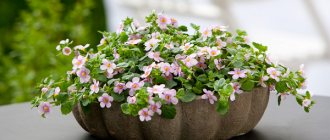How to choose a bacopa variety?
In nature, sutera grows in subtropical and tropical climates near lakes, rivers and swamps. Its stem quickly creeps along the ground and grows into new territories. In its original form, bacopa had only white flowers. However, over time, breeders have developed numerous variations: with different shades, large inflorescences, and double flowers.
Sutera blooms profusely throughout the summer and until mid-autumn. Even after rain, the inflorescences do not fall off and the plant does not lose its attractive appearance.
To choose the right sutera variety, you need to focus on the conditions in which the flower will be located. For example, plants with large or double flowers are more capricious than ordinary varieties. Therefore, to design vertical compositions, it is better to use unpretentious plants, since such bacopa has long shoots that will look beautiful even with traditional white flowers.
For decorating ponds or aquariums, the preferred variety is “Karolinska” or “Monier”. The first plant grows up to 30-40 cm. Bacopa “Carolinska” can grow even under water. Its stems smell like lemon when crushed and bloom with blue or blue flowers throughout the summer.
Bacopa Carolinica
The Monier variety is characterized by blue, white or pink flowers.
Varieties “Snowtopia” with white inflorescences and “Blutopia” - with blue ones are often used to decorate balconies, terraces and other open areas. Sutera varieties Snowflake and Cabana are showered with many large flowers in shades of pink, white or purple.
Sutera "Giant Snowflake" is a large variety with a long stem - 90 cm. It has small leaves and large white flowers. The bush is densely covered with snow-white inflorescences, falling in the form of a waterfall. This plant looks ideal in hanging pots or vertical compositions.
Sutera “Giant Snowflake”
For Bacopa "Olympic Gold" the distinctive feature is the golden hue of the leaves. They are complemented by snow-white flowers of medium size.
Suter flowers go well with fuchsias, nasturtiums, chrysanthemums and petunias. It is often used in flower beds and alpine hills as a ground cover. Bacopa grows well and forms a continuous carpet. In landscape design, it is used both as the main plant and to create a background.
Combination of bacopa with petunia
Also, original bouquets are made from sutera. This composition can maintain a fresh look for a long time.
Varieties
Breeders paid attention to bacopa only in the late 90s of the last century, but during this short time many new varieties and hybrids with various colors and larger flowers appeared. Each species, subspecies and breeding group has its own characteristics and strengths that must be taken into account when choosing a variety.
Experts recommend paying attention to the following types of bacopa:
- Caroline (Bacopa caroliniana). Changes the color of leaf plates depending on the illumination of the area. In the shade they are dark red, and in the sun they are light green. Requires high humidity and is often cultivated as a plant for a bottle garden. It is possible to grow on the shore of a pond or artificial reservoir. Sometimes it is located right on the coastline.
- Australian (Bacopa australis). Low-growing species, can grow directly in water. On the upper part protruding above the water, small blue flowers open.
- Monnieri (Bacopa monnieri). This succulent resembles a crassula (money tree) in miniature, but with cascading shoots. The leaves are so dense that the plant looks like a bright green mat or ball.
- Heart-shaped (Bacopa cordata) . Low-growing form, height - no more than 15 cm. Depending on the variety, the foliage can be medium in size or very small. Leaf blades with uneven cut edges.
- Spreading (Bacopa diffuses). Many varieties are capable of changing color during flowering: immediately after opening they are brighter, but fade over time. Since new buds form throughout the summer, petals of different colors can be seen on the bush, which makes it colorful and unusual. A nice feature is that even after rainy weather the plant does not become less attractive.
- Blutopia (Bacopa Blutopia F1). A wonderful hybrid for hanging cultivation, it blooms in powerful waves. Requires plenty of sun and fertilizing to reach its full potential.
- Snowtopia F1 white (White). Ideal for growing in hanging pots. The shoots hang down to 15 cm, but can grow up to 60 cm in width, which allows the hybrid to be used as a ground cover crop.
- Terry Ampel Snowball (Double Snowball). Double flowers are white with two rows of petals. Because of this, the crown looks very dense.
The most popular is the ampelous sutera; aquatic forms are grown mainly by landscape design specialists.
Planting bacopa
Bacopa is grown mainly by seedlings. The best time for growing is early March. You can sow seeds in February, but then you should provide an additional source of lighting.
Important! When choosing seeds, pay attention to their expiration date. Germination remains only for 3 years.
Good soil for planting sutera must meet the following requirements:
- loose, wet;
- with low acidity;
- must contain a mixture of peat and soil in equal proportions;
- processed by heat in the oven at a temperature of 80-90°C for 4 hours.
It is also recommended to add wet compost to the soil. When planting in vertical and suspended structures, the soil should be supplemented with humus and sand.
Pots with seedlings
Flower pots are placed on the sunny side, otherwise the bushes will begin to grow in length in the shade. The best option is a sunny area, shaded on a hot afternoon.
In the aquarium, the plant is illuminated with a fluorescent lamp, and sand or small pebbles are used as soil.
Photo of ampelous bacopa in the garden and interior
The delightful green foliage of ampelous bacopa flowers with small numerous inflorescences looks great in any stylistic direction of landscape design.
The plant is very impressive even as the only “inhabitant” of a flowerpot or hanging flowerpot.
Modern landscape designers have gone further: the lush foam of bacopa flowers is perfectly combined in one composition with plants such as petunia, pelargonium, nasturtium or dichondra. Each culture perfectly complements the other, which makes it possible to create stylish modern solutions for decorating the interior and garden.
Since the line of ampelous sutera varieties is distinguished by delicate pastel shades of petals, the plants are effectively combined with bright spots of other plants
Experienced gardeners recommend planting bacopa flowers around the perimeter, and petunia or other crops with brightly colored inflorescences in the center of the flowerpot.
Bacopa and petunia flowers are capable of creating magically attractive sketches from which it is impossible to take your eyes off
White bacopa flowers look stylish and harmonious with various shades of purple and blue in a textured wicker basket
Lush “clouds” of sutera flowers look especially romantic and sophisticated near artificial mini-reservoirs and fountains
Agrotechnical subtleties of growing bacopa
For successful cultivation, it is necessary to strictly fulfill the conditions for preparing the optimal location, soil quality and ensuring proper care:
- A drainage layer of fine crushed stone or river sand is poured into the planting pot, which prevents moisture from stagnating. Drainage prevents root rot and other diseases.
- Before planting, it is advisable to soak the seed material for 30 minutes in a solution of potassium permanganate.
- The seeds are sown superficially, not covered with soil, but only lightly compacted.
- The pot with seeds is covered with glass and set aside in a warm, bright place, ensuring the soil is moistened and ventilated.
- The room temperature should be around 20°C.
- After 2-3 weeks, the first shoots sprout. After this, the glass can be removed and the dense shoots thinned out.
- For successful growth, it is necessary that the soil maintains moisture and the sprouts receive nutrients.
- The first feeding is carried out 2 weeks after the sprouts appear. Then repeat every 12-15 days. Feeding should include phosphorus, nitrogen and potassium.
- The seedlings should be watered carefully, drop by drop, without allowing the soil to dry out. An abundance of moisture is also undesirable, as it can lead to rotting of the roots.
- When 3-4 leaves appear, it is time for the first picking. When replanting, the natural soil layer should be preserved.
- The pick is performed a second time at a permanent location. Strong bushes are planted, deepening them into the ground. This procedure will allow the development of additional roots, which in the future will give good rooting and ensure abundant flowering.
- Seedlings are planted at a distance of at least 10 cm between sprouts.
On a note! For planting, it is better to take transparent containers, in which it is easier to control the soil moisture.
In the second year of life, it is recommended to renew bacopa by separating cuttings from it for subsequent rooting.
Bacopa seedlings
Cuttings can be prepared from February to April or at the end of summer. Sprouts are obtained from an adult bacopa plant. A full-fledged cutting must have at least two internodes. The leaves are removed from the lower node and the plant is placed in water or a moist soil substrate. The fluid should be changed daily. After approximately 18 days, the sprouts are planted in the ground according to the seedling principle. To make the plant lush and beautiful, you should immediately pinch the top of the shoot.
How to grow Asarina climbing from seeds
Growing azarina from seeds is a rather lengthy process. It blooms no earlier than 4 months after sowing. Therefore, it is advisable to sow vine seeds no later than the end of February or beginning of March.
We begin sowing work by preparing the soil. The soil should be loose and fertile. A ready-made universal primer is quite suitable.
But it is better to prepare your own mixture of equal parts of humus, sand, peat, turf and leaf soil.
The soil for seedlings must be disinfected. Place it in the microwave for 10 minutes, and then spill it with a solution of potassium permanganate. After a day you can start sowing.
We fill the boxes with prepared soil and spread the seeds over its surface, lightly pressing them. Sprinkle the seeds on top with a thin layer of calcined but now cooled sand.
Cover the box with seedlings with film or glass and place it in a bright place. Don’t forget to regularly ventilate the crops and water them with a sprayer. At temperatures from +18 to 20 °C, the first shoots can be expected within two weeks. A week after this event, the “greenhouse” can be removed.
If you encounter a problem such as “black leg” when growing seedlings, remove the diseased sprouts with tweezers and water the soil with a solution of potassium permanganate. Then mix calcined sand with crushed charcoal and sprinkle the top layer of soil with this powder.
After the seedlings have two true leaves, we drop them into peat pots and provide the seedlings with good lighting and regular watering. When they grow up, we install a support in the form of a stick in each pot. In order for azarina to produce more shoots in the future, the tops of young plants must be pinched.
Transplantation into open ground
Before planting in open ground, sprouts should be prepared in advance for low temperatures. To do this, the seedlings are periodically placed in cooler conditions, gradually raising the temperature to 15°C. After hardening, young plants can be planted in the ground in the second half of May.
Seedlings in open ground
Bacopa will grow best in moist soil in light partial shade. When planting seedlings, you should maintain an interval between bushes of at least 20 cm.
If the temperature drops below 10°C, the sprouts should be covered with film.
Propagation by seeds
Sowing is carried out in the spring by placing bacopa seeds for germination in a small seedling pot and at a constant temperature of 15-18 ° C.
The soil is kept moist by spraying until the seeds germinate and then, when the new bacopa seedlings are strong enough and about 15cm tall, they can be transplanted into single pots.
The time from sowing to transplantation is 3 to 4 weeks. If propagation is carried out by cuttings, the bacopa branches must be cut off and planted in a container.
Fertilizer
In spring and autumn, the plant develops to its maximum, so during this period it should be fed three times a month with mineral and organic compounds. Among mineral fertilizers, it is better to choose mixtures that include potassium and nitrogen. Magnesium and manganese are also needed for the development of bacopa. This feeding will increase the brightness of the leaves and make the plant stronger.
Bacopa on the terrace
Trimming and picking
An unpruned sutera with a small number of branches does not look very attractive. Therefore, in order to achieve good bushiness and form a beautiful crown, you should start pruning immediately after rooting. Then pinching is carried out as the bush grows. Pruning is performed at the growth points of branches.
It is also necessary to pinch bacopa if the sprouts begin to elongate greatly.
On a note! For the bush to have an attractive appearance, the length of the shoot should not exceed 65 cm.
Before transplanting the sutera to a permanent place, it is necessary to make a pick. The first procedure is carried out after the seedlings have rooted and the third leaf appears. Young shoots are transplanted into common boxes and pots at a distance of at least 2 cm.
Botanical description
Bacopa is a herbaceous rhizomatous plant with flexible, creeping shoots. The fibrous root system is located very close to the surface of the earth. Although the length of the shoots can reach 70 cm, the height of the perennial does not exceed 10-15 cm. The stem lying directly on the ground can take root in the internodes. Along its entire length, small lanceolate or broadly oval leaves on short petioles are located close to each other. They grow in pairs, cross to cross. The bright green leaves are covered with small serrations on the sides.
Bacopa blooms very long and abundantly. Almost the entire warm season, the shoots are decorated with small axillary flowers. They bloom as if in waves: sometimes more abundantly, sometimes less, but are constantly present on the plant. The corolla of regular shape consists of 5 petals fused at the base into a short tube. Flowers of different varieties are colored red, pink, white, purple or blue. Their diameter does not exceed 2 cm. The core consists of short stamens with large bright yellow anthers and ovaries. After pollination, small flattened boxes with dry walls ripen. They contain many dust-like seeds.
Wintering Bacopa
Bacopa does not tolerate severe frosts, so the plant can only be preserved in a warm room. If the bush is brought to the balcony in time, flowering can continue until the New Year.
Bacopa indoors
The plant will be preserved well until spring in a bright room at a temperature from +8°C to +15°C. During winter, bacopa hardly grows and needs little moisture. However, you need to ensure that the soil does not dry out and the air in the room remains sufficiently humid. If you leave the plant in a room that is too warm for the winter, it will begin to shed its leaves and grow in length. In such conditions, sutera is susceptible to infection with gray rot and fungus.
In the second year of life, bacopas bloom worse, so it is recommended to rejuvenate them by pruning the branches and planting them to grow new specimens. There is no point in replanting an old plant again, since it will no longer look attractive.
How to properly care?
Sutera is an unpretentious plant, so it is not difficult for a gardener to care for it; just follow simple rules, and the crop will delight you with its lush flowering for many months.
Watering
The main secret to the successful growth and development of sutera is proper watering. The fact is that this crop is highly sensitive to drought, so it should be regularly moistened so that the earthen ball never completely dries out. At the same time, the crop does not tolerate excessive moisture - its roots begin to rot with excessive irrigation, which leads to a cessation of growth and development, and then to the death of the entire flower.
When planning to plant bacopa in one pot with other flowers or on its own, be sure to add up to 1/3 of the volume of the substrate of any baking powder to the soil. This can be perlite, vermiculite or fine-grained pebbles with a grain size of less than 0.5 mm. This method will help you protect the plant from excess moisture, which invariably occurs in peat.
Top dressing
Due to its high growth rate and lush, long-lasting flowering, bacopa requires frequent feeding - in this regard, it can be compared with crops such as surfinia and pelargonium. It is best to use liquid fertilizer, which can be purchased at any specialty store. The drug is added during irrigation, it is mixed with water and applied every second irrigation, but only half of the recommended dose is used.
In the first half of autumn, the plant enters a resting phase. It lasts until March; at this time there is no need for fertilizing.
Wintering
If you plan to get more seedlings for the next season, you can try saving bacopa until spring. To do this, the bushes must be cut at a level of 15-20 cm above the ground, and then moved to a bright room, the air temperature in which the composition does not exceed 20 degrees, and better - about 10 degrees.
Do not forget to replant the sutera annually in a new pot with updated substrate. This is best done in the spring before flowering begins. To do this, remove the plant from its previous container, shake off the remaining soil, carefully examine the root system and, if necessary, remove all dried and rotten roots. It is best to use a pot with large drainage holes. The best option would be a shallow, wide container, since the root system of bacopa is superficial.
The flower is placed in the very center of the new pot and sprinkled with fresh substrate around the perimeter. After replanting, the crop should be watered thoroughly until the soil is completely moistened. Excess moisture released into the pan is removed. If you notice that after moistening the soil has settled significantly, you need to add the required amount of soil.
Diseases and pests
With proper care, sutera is quite resistant to various pests and diseases. However, as a result of drying out the soil or over-wetting it, certain diseases can appear. For example, stagnant moisture and excessive plant density provoke the appearance of gray rot. In this case, the affected branches are removed, the plant is thinned out and watering is reduced.
In rare cases, bacopa is affected by aphids and whiteflies. When a bush is damaged by insects, the leaves begin to turn yellow and curl. The plant is sprayed with a solution of laundry soap 3 times a week. If such gentle treatment does not help, then you will have to purchase an insecticide.
Design option for bacopa bush
Medicinal properties of the plant
Bacopa is also known as a medicinal plant. The substances contained in it have antiseptic, healing, anti-inflammatory, tonic, sedative, diuretic and astringent properties. Suteru is known to be used for:
- collagen production and slowing down the aging process of the skin;
- strengthening the walls of the stomach and normalizing acidity;
- neutralization of alcohol;
- lowering cholesterol levels;
- getting rid of bacteria that carry genitourinary diseases;
- positive effect on the nervous system;
- stimulation of blood circulation in the brain.
Bacopa is most effective when combined with other medicinal plants. But when taking such drugs, a side effect was noted - men experienced a decrease in sperm activity, which negatively affected reproductive function.
Bacopa will decorate any flower bed, winter garden or home greenhouse. The main thing is to choose the right variety and provide the plant with proper care.
marked
Your opinion is very important to us. Please rate the article: rated 5 , rating: 3.20 out of 5
See also related articles
Stephanotis: home care, reproduction
Syngonium: home care, photo
Columnea: care at home, photo
Pilea: home care
Scindapsus: home care
Campanula: home care after purchase and transplantation
Philodendron: home care, photos, types
Ceropegia Wood: care at home
Epistation: care at home
Hedera "Helix mix": home care
Abutilon "Indoor maple": care at home
Dichondra “Emerald Falls”: growing from seeds at home
Add a comment Cancel reply
You must be logged in to post a comment.
✿ Alphabetical index
✿ Categories
- Houseplants
- Bromeliads
- Decorative foliage
- Trees and shrubs
- Orchids
- Succulents
- Blooming
- Perennial
✿ Popular articles
- How to grow chestnut from a nut at home in a pot
- Clematis: care and cultivation in the garden
- How to grow lemon from a seed at home with fruits: step by step
- Campanula: home care after purchase and transplantation
- How to grow pomegranate from seeds at home to produce fruits
- Decembrist flower: care at home, how to water correctly
✿ Latest comments
- Lyudmila on How to grow a lemon from a seed at home with fruits: step by step
- Tatyana on Tillandsia Anita: care at home
- LOVE for the entry Tulips: care and cultivation in the garden
Copyright © 2018-2021 GARDENER'S BOOK.
0+ By using bookgardener.ru you accept the terms of the USER AGREEMENT. Copyright for the posted materials belongs to the editors of the online magazine. When reprinting and using materials, an active hyperlink to BookGardener.ru is required
Bacopa care after planting
The conditions for caring for a bacopa bush at home and in the front garden are no different.
When growing sutera in the garden, you need to understand that the plant will need fertilizing, weeding, watering, loosening the soil, pruning, treatment against insects and protection from diseases. After planting flowers, it is necessary to provide the plant with good lighting, as well as direct sunlight. Since bacopa can withstand temperature changes and even slight frosts down to -5C, it is hung in flower pots from spring until late autumn.
Watering the plant
Water bacopa often and a lot, especially in dry times. After watering, fluff up the soil, taking care not to damage the roots. Also remove weeds carefully by hand.
Fertilizers and fertilizing
Regarding fertilizing, they are effective only for young plants. It is best to fertilize from spring to autumn once every ten days. As winter approaches, there is no need to fertilize the flowers. As a rule, sutera is fertilized with universal solutions enriched with minerals, as well as organic substances in the form of mullein and bird droppings.
Bacopa pruning
To make the flower bush better, pinch the ends of its shoots. If the plant stems become long enough, they can be trimmed. The cuttings from above that remain after pruning are used for further propagation. When the shoots become lignified and the flowering becomes less lush, the lower part of the flower is cut off by 1/3 of the length. Such manipulations are usually carried out in the fall.
You might be interested in this flower:
Gatsania from seeds: when to plant, propagation, difficulties of growing, diseases and pests, popular species with photos and names











